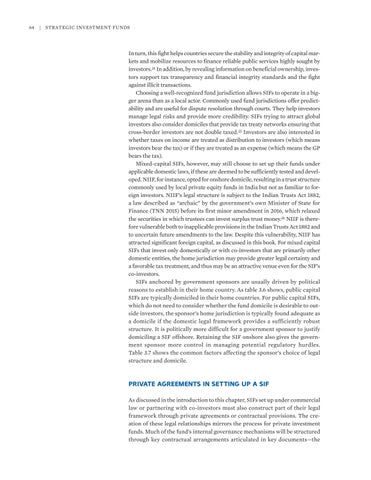64
| Strategic Investment Funds
In turn, this fight helps countries secure the stability and integrity of capital markets and mobilize resources to finance reliable public services highly sought by investors.24 In addition, by revealing information on beneficial ownership, investors support tax transparency and financial integrity standards and the fight against illicit transactions. Choosing a well-recognized fund jurisdiction allows SIFs to operate in a bigger arena than as a local actor. Commonly used fund jurisdictions offer predictability and are useful for dispute resolution through courts. They help investors manage legal risks and provide more credibility. SIFs trying to attract global investors also consider domiciles that provide tax treaty networks ensuring that cross-border investors are not double taxed.25 Investors are also interested in whether taxes on income are treated as distribution to investors (which means investors bear the tax) or if they are treated as an expense (which means the GP bears the tax). Mixed-capital SIFs, however, may still choose to set up their funds under applicable domestic laws, if these are deemed to be sufficiently tested and developed. NIIF, for instance, opted for onshore domicile, resulting in a trust structure commonly used by local private equity funds in India but not as familiar to foreign investors. NIIF’s legal structure is subject to the Indian Trusts Act 1882, a law described as “archaic” by the government’s own Minister of State for Finance (TNN 2015) before its first minor amendment in 2016, which relaxed the securities in which trustees can invest surplus trust money.26 NIIF is therefore vulnerable both to inapplicable provisions in the Indian Trusts Act 1882 and to uncertain future amendments to the law. Despite this vulnerability, NIIF has attracted significant foreign capital, as discussed in this book. For mixed capital SIFs that invest only domestically or with co-investors that are primarily other domestic entities, the home jurisdiction may provide greater legal certainty and a favorable tax treatment, and thus may be an attractive venue even for the SIF’s co-investors. SIFs anchored by government sponsors are usually driven by political reasons to establish in their home country. As table 3.6 shows, public capital SIFs are typically domiciled in their home countries. For public capital SIFs, which do not need to consider whether the fund domicile is desirable to outside investors, the sponsor’s home jurisdiction is typically found adequate as a domicile if the domestic legal framework provides a sufficiently robust structure. It is politically more difficult for a government sponsor to justify domiciling a SIF offshore. Retaining the SIF onshore also gives the government sponsor more control in managing potential regulatory hurdles. Table 3.7 shows the common factors affecting the sponsor’s choice of legal structure and domicile.
PRIVATE AGREEMENTS IN SETTING UP A SIF As discussed in the introduction to this chapter, SIFs set up under commercial law or partnering with co-investors must also construct part of their legal framework through private agreements or contractual provisions. The creation of these legal relationships mirrors the process for private investment funds. Much of the fund’s internal governance mechanisms will be structured through key contractual arrangements articulated in key documents—the

